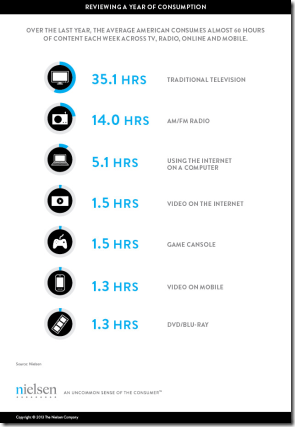Nielsen, a company that measures what consumers watch and listen to, released a report this month noting that “more than ninety percent of Americans listen to radio each week.
Actually, on average Americans listen to two hours of AM/FM radio per day. Listenership zooms up between 3 am and 4 am, plateaus from 7 am to 5 pm and then tails off dramatically.
Shown in this blog is Nielsen’s calculation of how Americans, on average, spend 60 hours of content viewing and listening each week including 14 hours of AM/FM radio.
Also shown is a Scarborough breakdown of last year’s “heavy” radio listeners by generation. If you are wondering if I listen as I write this blog, I don’t.
I primarily listen to the radio only while I am shaving and showering, or in the kitchen feeding the dogs, or when I am in the Jeep running errands, so I probably don’t count in the 10% of people 65+ who are “heavy” radio listeners.
I am even more likely to read radio news online via an app than listen to it. This may be why NPR has around 27 million listeners, down slightly, but its web traffic zoomed up a third to 17.7 million in 2011 over the previous year.
But my habits may give a sense of radio’s dilemma. It is relegated to background and increasingly replaced for actual listening by streaming services such as Pandora or satellite radio. Studies show that nearly 80% of AM/FM radio listeners change the station when ads come on.
This may also explain why studies show “heavy” radio users are significantly more likely to also be Internet users.
One reason why global ad spending forecast between 2003 and 2016 has radio and outdoor advertising including billboards falling to between 6.3% and 6.9% each is that the latter is obsolete and destructive and on the former is rated seven times less effective than on Internet music streaming services such as Pandora for advertisers.
Ad spending on the Internet will blow by television this year and nearly double it over the next two. This will be almost ten times the amount spent on all of outdoor advertising including the shrinking portion that is on billboards.
Forty percent of Millennials use the Internet to listen to the radio but not necessarily AM/FM stations. A 2012 Pew Research report showed that Americans were listening more nine hours a day to online radio. The percent listening to audio on digital devices is expected to double to 80% by 2015.
Of those age 12 and over who “love” radio are 22% cite local AM/FM, 32% cite Pandora and 39% cite Satellite.
A Harris survey last month noted that 52% of Americans subscribe to cable television and 25% to satellite television services, while 25% use Netflix, 13% subscribe to Amazon Prime and 4% subscribe to Hulu.
According to a survey a few months ago, 28% of Americans who own Smart TVs and an incredible 18% of non-smart TV owners already consider Pandora’s music streaming a must-have for their television. For Netflix, the percentages were 47% and 34%.
Sometimes viewer/listener surveys on behalf of traditional television and radio take on the tone of “quick, look over there,” by pointing to newspapers and magazines but the underlying desperation is clear.
This change must be disconcerting, whatever the pace, particularly for those with stranded capital costs. But radio stations, rather than rest assured, should learn from newspapers and magazines and start much earlier to experiment with transitions to a new model.
This streaming thing, if not here to stay in its current way, is only the beginning of many paradigm sea changes to come.
2 comments:
Yeah. I think within a few years standard radio will have a huge problem. Even now I only listen to it while driving, and otherwise have pandora or torch music playing. As these services make it into automobiles it'll be even harder to maintain listener-ship. I think you're right, they have to go digital if they want to survive, and if they don't it's on them for not paying attention.
Yeah. I think within a few years standard radio will have a huge problem. Even now I only listen to it while driving, and otherwise have pandora or torch music playing. As these services make it into automobiles it'll be even harder to maintain listener-ship. I think you're right, they have to go digital if they want to survive, and if they don't it's on them for not paying attention.
Post a Comment